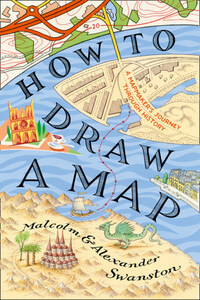COPYRIGHT
HarperCollinsPublishers
1 London Bridge Street
London SE1 9GF
www.harpercollins.co.uk
First published by HarperCollinsPublishers 2019
FIRST EDITION
© Malcolm Swanston and Alexander Swanston 2019
Cover design by Claire Ward © HarperCollinsPublishers Ltd 2019
Cover illustration © Neil Gower
A catalogue record of this book is available from the British Library
Malcolm Swanston and Alexander Swanston assert the moral right to be identified as the authors of this work
All rights reserved under International and Pan-American Copyright Conventions. By payment of the required fees, you have been granted the nonexclusive, non-transferable right to access and read the text of this e-book on screen. No part of this text may be reproduced, transmitted, downloaded, decompiled, reverse engineered, or stored in or introduced into any information storage retrieval system, in any form or by any means, whether electronic or mechanical, now known or hereinafter invented, without the express written permission of HarperCollins e-books.
Find out about HarperCollins and the environment at www.harpercollins.co.uk/green
Source ISBN: 9780008275792
Ebook Edition © September 2019 ISBN: 9780008275815
Version 2019-08-20
CONTENTS
Cover
Title Page
Copyright
Dedication
Introduction
1. Lost in Eden
2. Anaximander’s Vision
3. The Legacy of Rome
4. The Road to Paradise
5. Visions of a New World
6. Pre-Columbian Voyages in the Atlantic
7. The First Circumnavigation of the World
8. The English World View
9. Mercator Navigates the World
10. Terra Australis (‘South Land’)
11. Enslaved
12. The Cassinis’ Conceptions
13. The Problem with Empires
14. Gone West
15. A World at War
16. The Second Round
17. Cities
18. Another View of Earth
Acknowledgements
About the Publisher
INTRODUCTION
In one way or another, we are all mapmakers at heart. I am sure we have an inbuilt urge to understand the world around us and beyond; how do we, or at least our part of the world, fit into the great scheme of things?
Ever since I can remember, I have been completely absorbed in atlases and maps of all kinds. As a child, I received one particular book that enthralled me for years: The History of Our Earth, in which talented artists re-created scenes across double-page spreads of landscapes featuring early dinosaurs, exotic creatures of the desert, human migrations and early civilisations; its well-worn pages are still with me. The moment I first open an atlas, whether it is political, physical, topographical or an historical atlas of any kind on any subject, huge periods of time seem to fly by unaccountably. This affliction has lasted the whole of my lifetime and I appear to have passed it on to one of my children, who is engaged in the production of maps, including the ones used in this book.
My first cartographic undertaking (although I didn’t realise it at the time) was not far from my childhood home, at a milecastle. As the name suggests, these were fortified posts built every Roman mile along Hadrian’s Wall. Interspersed between major forts, these milecastles and smaller turrets contained about 50 men to keep watch, usually out to the north. I would set about measuring the visible remains of ‘my’ castle and working out how its garrison fitted within its walls. My measuring system was a length of rope cunningly adapted to its new use by having a knot tied every yard, and thus I was able to create a five-yard system. Well equipped with a quarter-inch grid in my school notebook, two pencils and a pencil sharpener, and lavishly provisioned with cheese and pickle sandwiches and a bottle of Coke, I set off. I should say we set off, as I had recruited my next-door neighbour and school friend Rob to help (facing the unknown alone was too daunting) – a latter-day Mason and Dixon (see here).
We measured the milecastle at Gilsland, which, in the 1950s, was in the county of Cumberland but is now part of Cumbria; it is still in my memory six decades later. The milecastle is known to modern archaeology as Milecastle 49 at Harrows Scar. It proved to be 19.8 metres (approximately 30 yards) east to west and 22.9 metres (approximately 32 yards) north to south. It is now in the care of English Heritage. Its monument number, if you are interested in such things, is 13987.
Since the River Irthing was not too far away and stocked with trout prepared to present themselves for capture and the frying pan, this was our next port of call and, I suspect, Rob’s real reason for coming along. We succeeded; we came away with the fish and having recorded the edge of the Roman Empire.
My career since then has been almost completely focused on thematic maps – those which display a particular theme, topic or subject of discourse, rather than road maps, with which we are all familiar. Over the course of my life, I have accrued over 50 years of map creation and during these decades cartography has seen the most profound changes, the greatest of which has been technology: the move from physical craftsmanship to the use of computers. Trading the pen, scalpel and scribing tool for software and the mouse marked a significant evolution in the craft of mapmaking.








